



FBU Grant Recipients

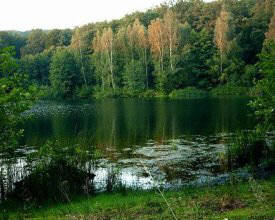
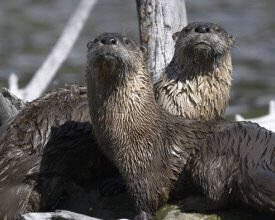
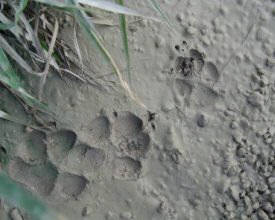




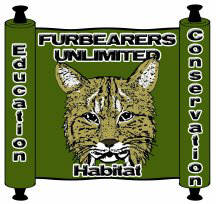
Furbearers Unlimited, Inc., is a 501(c)(3) nonprofit corporation.






The Wisconsin Department of Natural Resources (WDNR) and the Wisconsin Trappers Association (WTA) offers a "hands on" Furbearer Ecology Workshop originally designed for college students at the University of Wisconsin Stevens Point, University of Wisconsin Madison and Northland College in Ashland. The course, based on a 5-day course previously taught at Madison to WDNR personnel, covered the basics of furbearer ecology, management, trapping and fur handling. Through a mixture of lectures ,discussions, and activities, students get a first-hand experience with se3tting traps and skinning animals, as well as how we manage the furbearers of the state. This workshop has become the focus of departments across the country as many other Fish and Game and Wildlife Agency persons will now be attending.
Wisconsin Furbearer Ecology Workshop
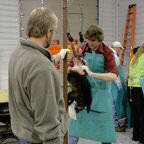
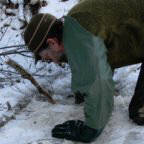
Delta Waterfowl Predator Study
Delta Waterfowl established a multi-year investigation into a central question in waterfowl management: how do increased densities of ducks influence recruitment? This work is made possible by variation in duck densities caused by several years of predator trapping on township sized blocks of habitat, in addition to representing a new phase of Delta’s work on how predator management affects duck production. This includes 28 projects all over North America which investigate various aspects of waterfowl and wetland ecology.
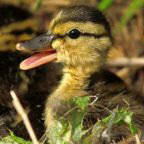
To validate the successful reintroduction of river otters in Ohio and learn more about their ecology, the Ohio Division of' Wildlife teamed up with West Virginia University to study the use of habitats, movements and survival of river otters in the Killbuck Watershed. which the largest wetland complex in Ohio outside of the state's Lake Erie marshes. With financial support from FurBearers Unlimited. WVU graduate student Dave Helon radio-tracked river otters during the spring and summer of 2002-03 to identity habitat use and movements of river otters, while the Division of Wildlife monitored their survival year-round. Continued support from FurBearers Unlimited in 2004 allowed the Division of Wildlife to purchase a Beavertail outboard motor, which was used to traverse extensive areas of shallow marsh and rivers choked with woody debris to trap and radio-mark additional river otters. This resulted in a dramatic increase in the number of river otters (37) available for the research project .
Home Range, Habitat Use, Movement & Survival of River Otter in Ohio
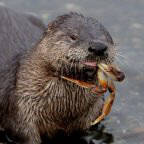
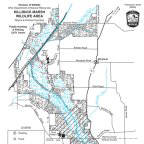
In 2002 the Iowa State University (ISU) in cooperation with the Iowa Department of Natural Resources, initiated a study of the recovery of the bobcat (Lynx rufus), a species which has become increasingly common in the corn belt of the Midwest. The study was prompted by the reports of bobcats from about two-thirds of the counties of Iowa in the last 5 years and the need for basic data to manage the species. ISU has now been radio-collaring bobcats in southern Iowa for the last 3 years. Hopefully this project will answer questions with regard to the distribution, landscape ecology, and population dynamics. Given that the public expresses desires that range from complete protection of bobcats to opening a limited harvest season, we must be prepared to define management options based on sound scientific data.
Iowa Bobcat Study
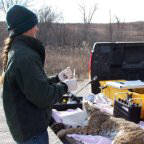
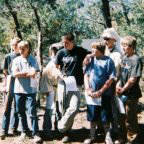
The Arizona Trappers Association put on two training sessions in April for the Boy Scouts. The first one was in Las Vegas, Nevada and attended by not only Boy Scouts, but also the Explorer Post, Cub Scouts, and Girl Scouts-who probably were the most interested, as their program does not fully address outdoor activities. The Scout troops specialize in primitive skills, and are very interested in rendezvous events, trapping and survival skills. These sessions are very helpful in presenting wildlife management in a positive aspect and showing the participants the different varieties of fur from the south west. The Trapper's Handbook is given to troops for their libraries, and trapping skills are demonstrated, from the early iron trap , weapons, and tools of the Mountain Man to what today's modern trapper is using.

Arizona Boy Scout Rendezvous

Children's Hands-On Museum of Tuscaloosa, AL
Children can now explore a riverbank environment and its woodland inhabitants at the Beavers Bend exhibit.
By visiting the beaver's lodge, students learn about animal habitats, the natural world and our ecosystem.
By visiting the beaver's lodge, students learn about animal habitats, the natural world and our ecosystem.
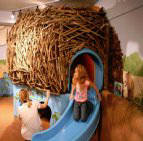
Since FurBearers Unlimited inception in 1988, many successful projects and programs have been supported. The following is a summary of the activities that FurBearers Unlimitad has had the opportunity to assist financially. Furthering the goals of wildlife management as well as protecting habitats that are essential to all wildlife and our environment.

Grant Recipients
Beaver Reintroduction - Gallatin River System in Southwestern Montana
Financial assistance was provided to the Montana Division of Game, Fish and Parks, U.S. Forest Service and the Montana Trappers Association for the capture and reintroduction of beaver back into the Gallatin River system. Beaver were historically an important component of the ecosystem, however beaver had been absent from the drainage for decades. This project appears to have been very successful.
Financial assistance was provided to the Montana Division of Game, Fish and Parks, U.S. Forest Service and the Montana Trappers Association for the capture and reintroduction of beaver back into the Gallatin River system. Beaver were historically an important component of the ecosystem, however beaver had been absent from the drainage for decades. This project appears to have been very successful.
Pine Martin Habitat Research - Montana Old Growth versus New Growth Timber Stands
This was a cooperative study between the University of Montana, U.S. Forest service and FBU, to document Pine Martin habitat preferences, home range, behavior, and relationships to old growth timber versus new growth timber.
This was a cooperative study between the University of Montana, U.S. Forest service and FBU, to document Pine Martin habitat preferences, home range, behavior, and relationships to old growth timber versus new growth timber.
Impacts on Furbearing Mammals in Fragmented Habitat Types and Contrasting Nutritional and Behavior Ecology of Coyotes in Various Landscapes
Both research projects were conducted by Purdue University evaluating densities and behavior of fur-bearing species found in habitats modified by human activity.
Both research projects were conducted by Purdue University evaluating densities and behavior of fur-bearing species found in habitats modified by human activity.
Yukon - Kuskokwim Mink Festival
A donation was made to assist the Alaska Fish and Game Department, Alaska Trappers Association and the sponsors of the Fur Festival to train the youth of this Delta region to the proper techniques of trapping and fur handling. This region is the homeland of the Yupik Eskimos and trapping was once a major part of their economy and lifestyle. The funds that were donated by FBU were used to convert trapping educational videos into the Yupik language.
A donation was made to assist the Alaska Fish and Game Department, Alaska Trappers Association and the sponsors of the Fur Festival to train the youth of this Delta region to the proper techniques of trapping and fur handling. This region is the homeland of the Yupik Eskimos and trapping was once a major part of their economy and lifestyle. The funds that were donated by FBU were used to convert trapping educational videos into the Yupik language.